Analyzing Food Waste Management Practices at Hilton Auckland
VerifiedAdded on 2023/06/03
|18
|5096
|309
Literature Review
AI Summary
This literature review delves into food waste management practices within the context of Hilton Auckland, highlighting the escalating global concern of food wastage and its environmental and economic repercussions. The review identifies key factors contributing to food waste, such as inadequate menu planning, stringent food safety protocols, over-preparation of food driven by intense competition, and varying customer preferences. It examines the impact of food waste on biodiversity, water resources, and carbon footprint, emphasizing the urgent need for comprehensive waste management strategies. The review further discusses the importance of balancing demand and production, fostering collaboration across food service operations, and implementing models like 'The Food Waste Hierarchy' to minimize waste generation and promote sustainability. This study provides valuable insights for mitigating food waste issues in the hospitality industry and beyond.
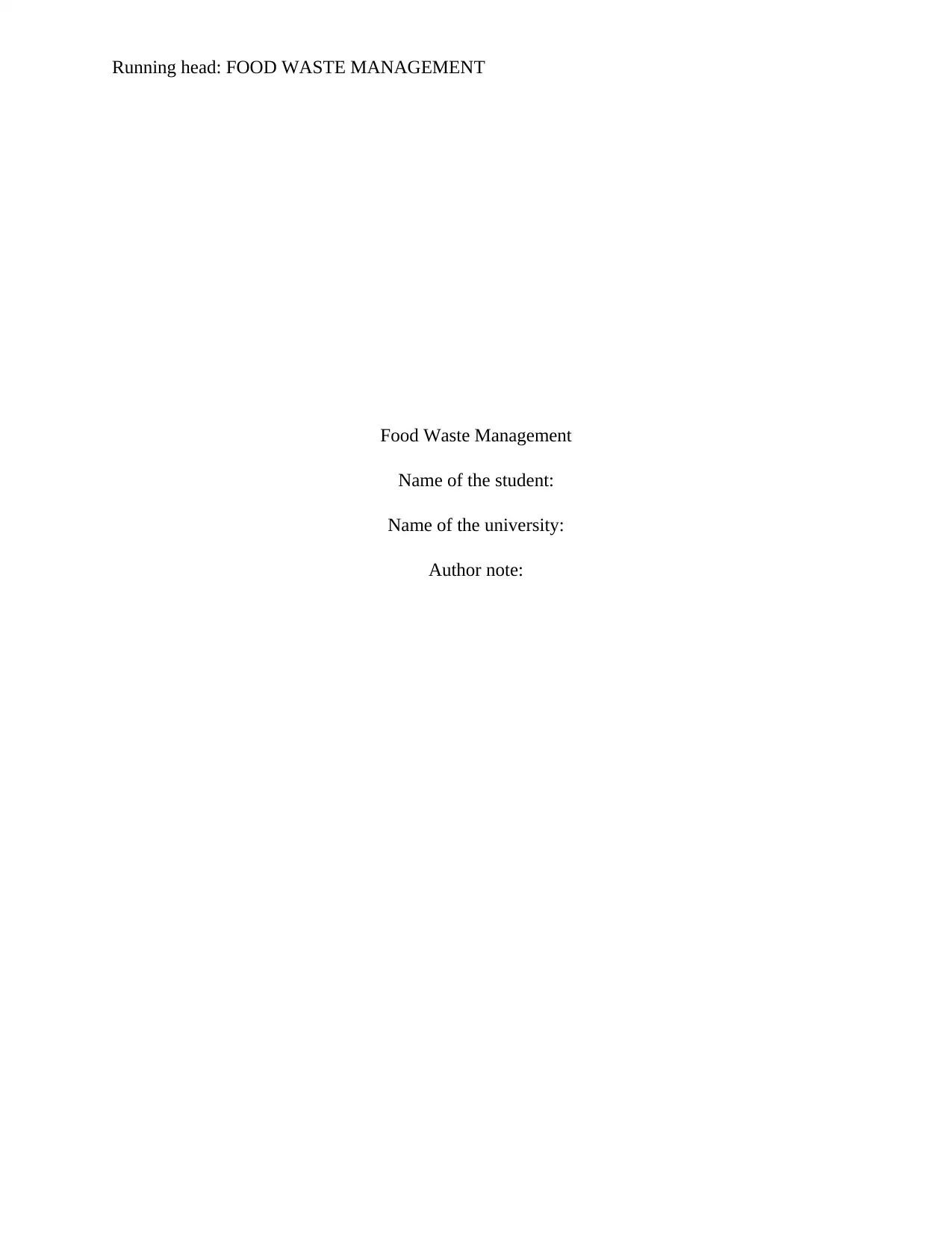
Running head: FOOD WASTE MANAGEMENT
Food Waste Management
Name of the student:
Name of the university:
Author note:
Food Waste Management
Name of the student:
Name of the university:
Author note:
Paraphrase This Document
Need a fresh take? Get an instant paraphrase of this document with our AI Paraphraser
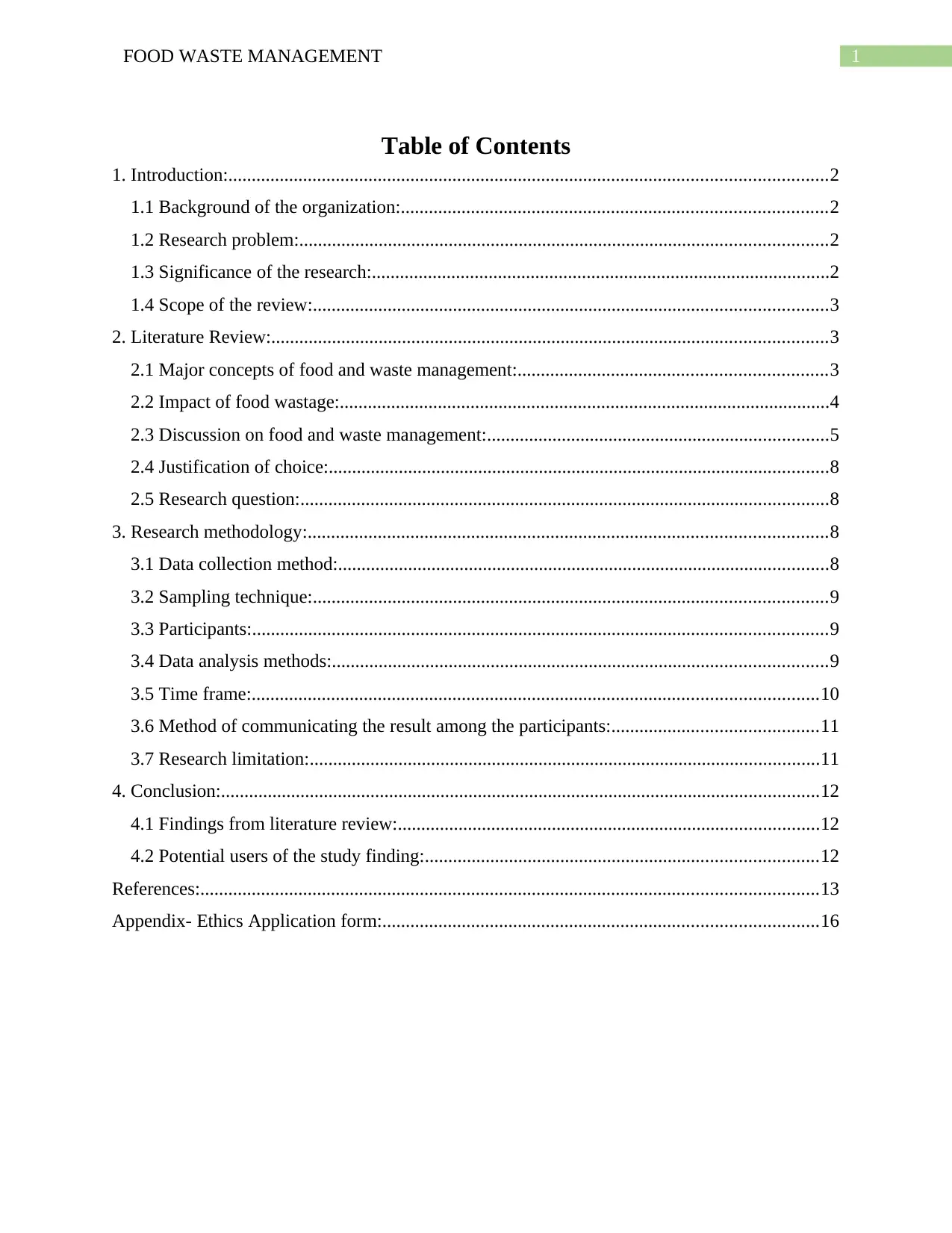
1FOOD WASTE MANAGEMENT
Table of Contents
1. Introduction:................................................................................................................................2
1.1 Background of the organization:...........................................................................................2
1.2 Research problem:.................................................................................................................2
1.3 Significance of the research:..................................................................................................2
1.4 Scope of the review:..............................................................................................................3
2. Literature Review:.......................................................................................................................3
2.1 Major concepts of food and waste management:..................................................................3
2.2 Impact of food wastage:.........................................................................................................4
2.3 Discussion on food and waste management:.........................................................................5
2.4 Justification of choice:...........................................................................................................8
2.5 Research question:.................................................................................................................8
3. Research methodology:...............................................................................................................8
3.1 Data collection method:.........................................................................................................8
3.2 Sampling technique:..............................................................................................................9
3.3 Participants:...........................................................................................................................9
3.4 Data analysis methods:..........................................................................................................9
3.5 Time frame:.........................................................................................................................10
3.6 Method of communicating the result among the participants:............................................11
3.7 Research limitation:.............................................................................................................11
4. Conclusion:................................................................................................................................12
4.1 Findings from literature review:..........................................................................................12
4.2 Potential users of the study finding:....................................................................................12
References:....................................................................................................................................13
Appendix- Ethics Application form:.............................................................................................16
Table of Contents
1. Introduction:................................................................................................................................2
1.1 Background of the organization:...........................................................................................2
1.2 Research problem:.................................................................................................................2
1.3 Significance of the research:..................................................................................................2
1.4 Scope of the review:..............................................................................................................3
2. Literature Review:.......................................................................................................................3
2.1 Major concepts of food and waste management:..................................................................3
2.2 Impact of food wastage:.........................................................................................................4
2.3 Discussion on food and waste management:.........................................................................5
2.4 Justification of choice:...........................................................................................................8
2.5 Research question:.................................................................................................................8
3. Research methodology:...............................................................................................................8
3.1 Data collection method:.........................................................................................................8
3.2 Sampling technique:..............................................................................................................9
3.3 Participants:...........................................................................................................................9
3.4 Data analysis methods:..........................................................................................................9
3.5 Time frame:.........................................................................................................................10
3.6 Method of communicating the result among the participants:............................................11
3.7 Research limitation:.............................................................................................................11
4. Conclusion:................................................................................................................................12
4.1 Findings from literature review:..........................................................................................12
4.2 Potential users of the study finding:....................................................................................12
References:....................................................................................................................................13
Appendix- Ethics Application form:.............................................................................................16
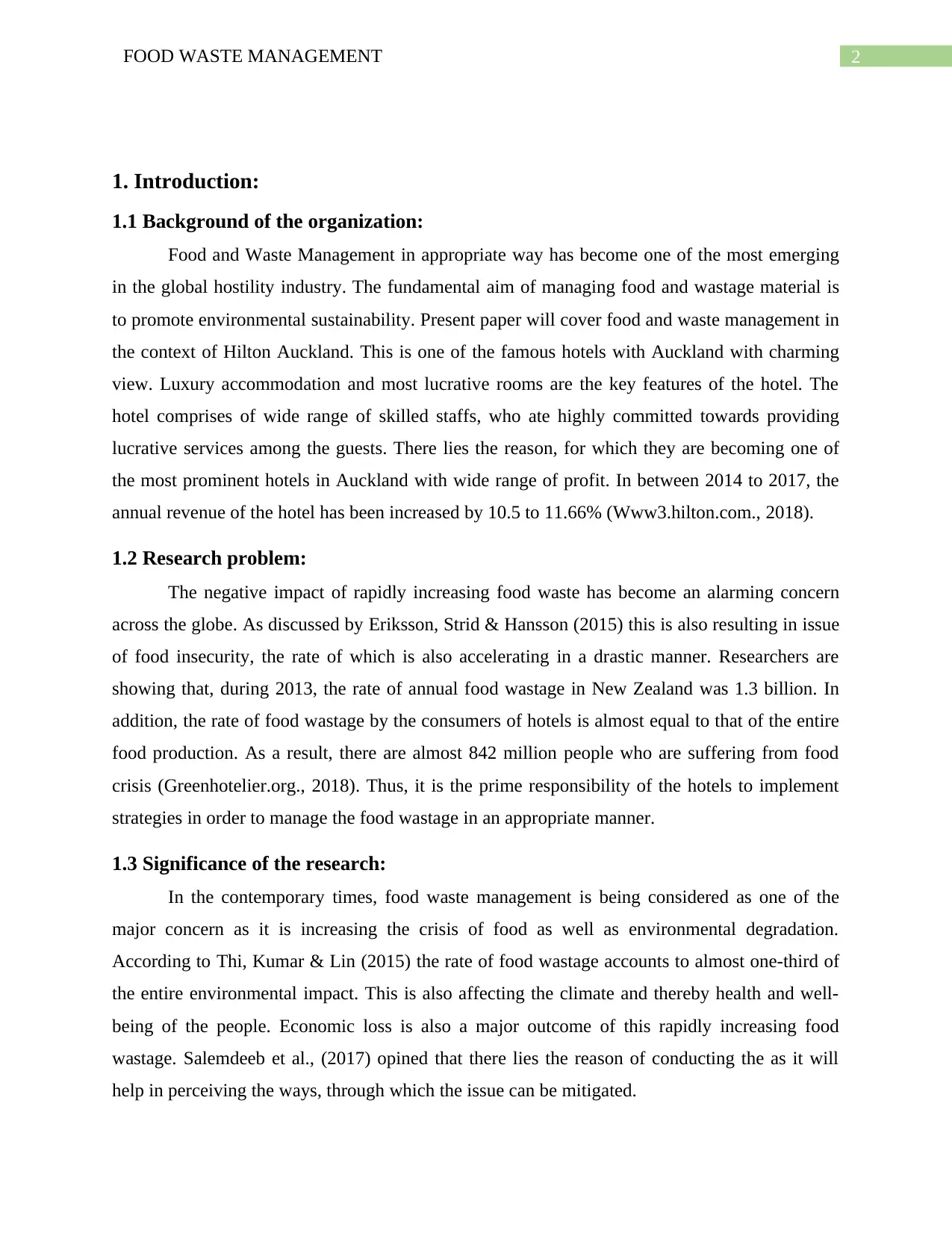
2FOOD WASTE MANAGEMENT
1. Introduction:
1.1 Background of the organization:
Food and Waste Management in appropriate way has become one of the most emerging
in the global hostility industry. The fundamental aim of managing food and wastage material is
to promote environmental sustainability. Present paper will cover food and waste management in
the context of Hilton Auckland. This is one of the famous hotels with Auckland with charming
view. Luxury accommodation and most lucrative rooms are the key features of the hotel. The
hotel comprises of wide range of skilled staffs, who ate highly committed towards providing
lucrative services among the guests. There lies the reason, for which they are becoming one of
the most prominent hotels in Auckland with wide range of profit. In between 2014 to 2017, the
annual revenue of the hotel has been increased by 10.5 to 11.66% (Www3.hilton.com., 2018).
1.2 Research problem:
The negative impact of rapidly increasing food waste has become an alarming concern
across the globe. As discussed by Eriksson, Strid & Hansson (2015) this is also resulting in issue
of food insecurity, the rate of which is also accelerating in a drastic manner. Researchers are
showing that, during 2013, the rate of annual food wastage in New Zealand was 1.3 billion. In
addition, the rate of food wastage by the consumers of hotels is almost equal to that of the entire
food production. As a result, there are almost 842 million people who are suffering from food
crisis (Greenhotelier.org., 2018). Thus, it is the prime responsibility of the hotels to implement
strategies in order to manage the food wastage in an appropriate manner.
1.3 Significance of the research:
In the contemporary times, food waste management is being considered as one of the
major concern as it is increasing the crisis of food as well as environmental degradation.
According to Thi, Kumar & Lin (2015) the rate of food wastage accounts to almost one-third of
the entire environmental impact. This is also affecting the climate and thereby health and well-
being of the people. Economic loss is also a major outcome of this rapidly increasing food
wastage. Salemdeeb et al., (2017) opined that there lies the reason of conducting the as it will
help in perceiving the ways, through which the issue can be mitigated.
1. Introduction:
1.1 Background of the organization:
Food and Waste Management in appropriate way has become one of the most emerging
in the global hostility industry. The fundamental aim of managing food and wastage material is
to promote environmental sustainability. Present paper will cover food and waste management in
the context of Hilton Auckland. This is one of the famous hotels with Auckland with charming
view. Luxury accommodation and most lucrative rooms are the key features of the hotel. The
hotel comprises of wide range of skilled staffs, who ate highly committed towards providing
lucrative services among the guests. There lies the reason, for which they are becoming one of
the most prominent hotels in Auckland with wide range of profit. In between 2014 to 2017, the
annual revenue of the hotel has been increased by 10.5 to 11.66% (Www3.hilton.com., 2018).
1.2 Research problem:
The negative impact of rapidly increasing food waste has become an alarming concern
across the globe. As discussed by Eriksson, Strid & Hansson (2015) this is also resulting in issue
of food insecurity, the rate of which is also accelerating in a drastic manner. Researchers are
showing that, during 2013, the rate of annual food wastage in New Zealand was 1.3 billion. In
addition, the rate of food wastage by the consumers of hotels is almost equal to that of the entire
food production. As a result, there are almost 842 million people who are suffering from food
crisis (Greenhotelier.org., 2018). Thus, it is the prime responsibility of the hotels to implement
strategies in order to manage the food wastage in an appropriate manner.
1.3 Significance of the research:
In the contemporary times, food waste management is being considered as one of the
major concern as it is increasing the crisis of food as well as environmental degradation.
According to Thi, Kumar & Lin (2015) the rate of food wastage accounts to almost one-third of
the entire environmental impact. This is also affecting the climate and thereby health and well-
being of the people. Economic loss is also a major outcome of this rapidly increasing food
wastage. Salemdeeb et al., (2017) opined that there lies the reason of conducting the as it will
help in perceiving the ways, through which the issue can be mitigated.
⊘ This is a preview!⊘
Do you want full access?
Subscribe today to unlock all pages.

Trusted by 1+ million students worldwide
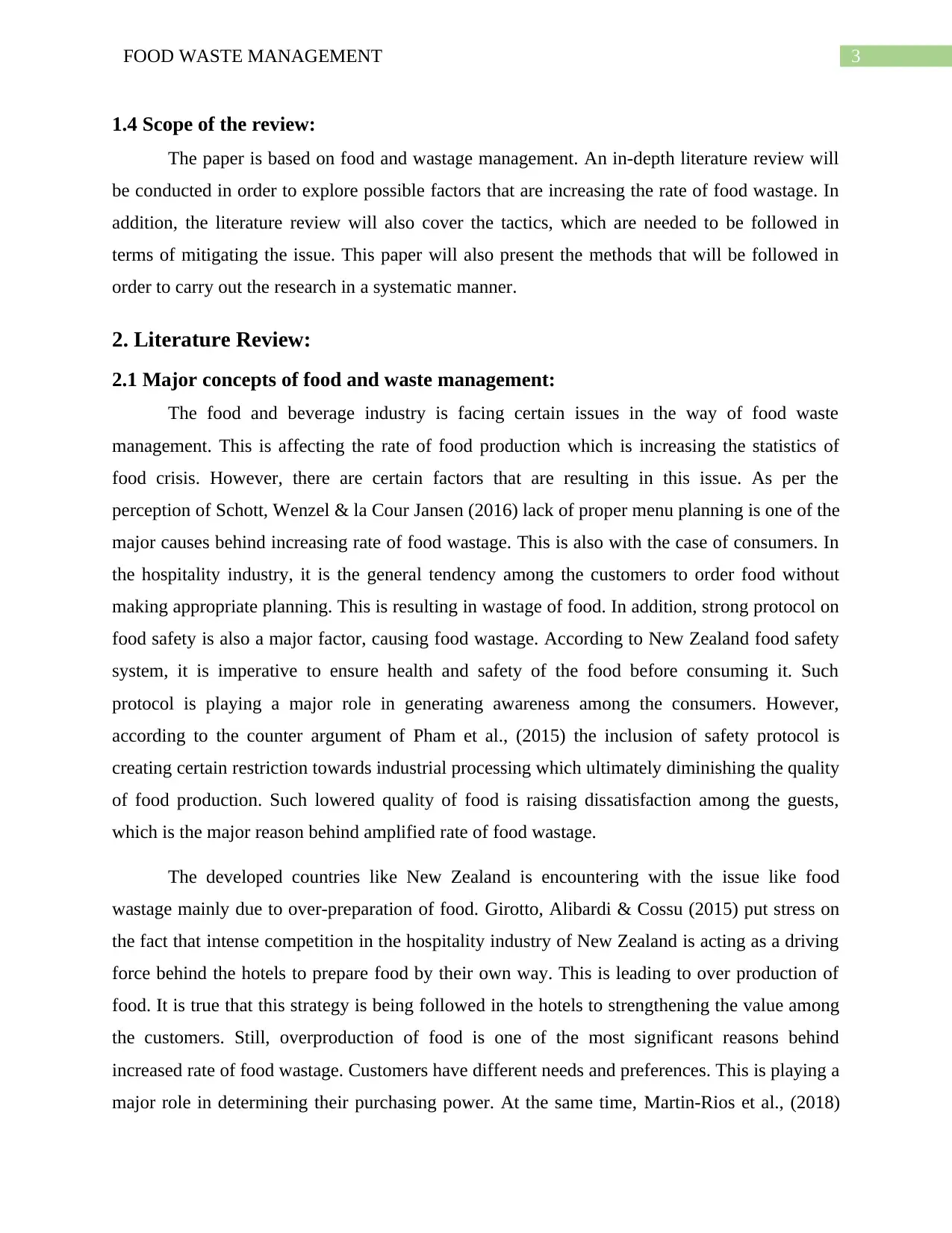
3FOOD WASTE MANAGEMENT
1.4 Scope of the review:
The paper is based on food and wastage management. An in-depth literature review will
be conducted in order to explore possible factors that are increasing the rate of food wastage. In
addition, the literature review will also cover the tactics, which are needed to be followed in
terms of mitigating the issue. This paper will also present the methods that will be followed in
order to carry out the research in a systematic manner.
2. Literature Review:
2.1 Major concepts of food and waste management:
The food and beverage industry is facing certain issues in the way of food waste
management. This is affecting the rate of food production which is increasing the statistics of
food crisis. However, there are certain factors that are resulting in this issue. As per the
perception of Schott, Wenzel & la Cour Jansen (2016) lack of proper menu planning is one of the
major causes behind increasing rate of food wastage. This is also with the case of consumers. In
the hospitality industry, it is the general tendency among the customers to order food without
making appropriate planning. This is resulting in wastage of food. In addition, strong protocol on
food safety is also a major factor, causing food wastage. According to New Zealand food safety
system, it is imperative to ensure health and safety of the food before consuming it. Such
protocol is playing a major role in generating awareness among the consumers. However,
according to the counter argument of Pham et al., (2015) the inclusion of safety protocol is
creating certain restriction towards industrial processing which ultimately diminishing the quality
of food production. Such lowered quality of food is raising dissatisfaction among the guests,
which is the major reason behind amplified rate of food wastage.
The developed countries like New Zealand is encountering with the issue like food
wastage mainly due to over-preparation of food. Girotto, Alibardi & Cossu (2015) put stress on
the fact that intense competition in the hospitality industry of New Zealand is acting as a driving
force behind the hotels to prepare food by their own way. This is leading to over production of
food. It is true that this strategy is being followed in the hotels to strengthening the value among
the customers. Still, overproduction of food is one of the most significant reasons behind
increased rate of food wastage. Customers have different needs and preferences. This is playing a
major role in determining their purchasing power. At the same time, Martin-Rios et al., (2018)
1.4 Scope of the review:
The paper is based on food and wastage management. An in-depth literature review will
be conducted in order to explore possible factors that are increasing the rate of food wastage. In
addition, the literature review will also cover the tactics, which are needed to be followed in
terms of mitigating the issue. This paper will also present the methods that will be followed in
order to carry out the research in a systematic manner.
2. Literature Review:
2.1 Major concepts of food and waste management:
The food and beverage industry is facing certain issues in the way of food waste
management. This is affecting the rate of food production which is increasing the statistics of
food crisis. However, there are certain factors that are resulting in this issue. As per the
perception of Schott, Wenzel & la Cour Jansen (2016) lack of proper menu planning is one of the
major causes behind increasing rate of food wastage. This is also with the case of consumers. In
the hospitality industry, it is the general tendency among the customers to order food without
making appropriate planning. This is resulting in wastage of food. In addition, strong protocol on
food safety is also a major factor, causing food wastage. According to New Zealand food safety
system, it is imperative to ensure health and safety of the food before consuming it. Such
protocol is playing a major role in generating awareness among the consumers. However,
according to the counter argument of Pham et al., (2015) the inclusion of safety protocol is
creating certain restriction towards industrial processing which ultimately diminishing the quality
of food production. Such lowered quality of food is raising dissatisfaction among the guests,
which is the major reason behind amplified rate of food wastage.
The developed countries like New Zealand is encountering with the issue like food
wastage mainly due to over-preparation of food. Girotto, Alibardi & Cossu (2015) put stress on
the fact that intense competition in the hospitality industry of New Zealand is acting as a driving
force behind the hotels to prepare food by their own way. This is leading to over production of
food. It is true that this strategy is being followed in the hotels to strengthening the value among
the customers. Still, overproduction of food is one of the most significant reasons behind
increased rate of food wastage. Customers have different needs and preferences. This is playing a
major role in determining their purchasing power. At the same time, Martin-Rios et al., (2018)
Paraphrase This Document
Need a fresh take? Get an instant paraphrase of this document with our AI Paraphraser
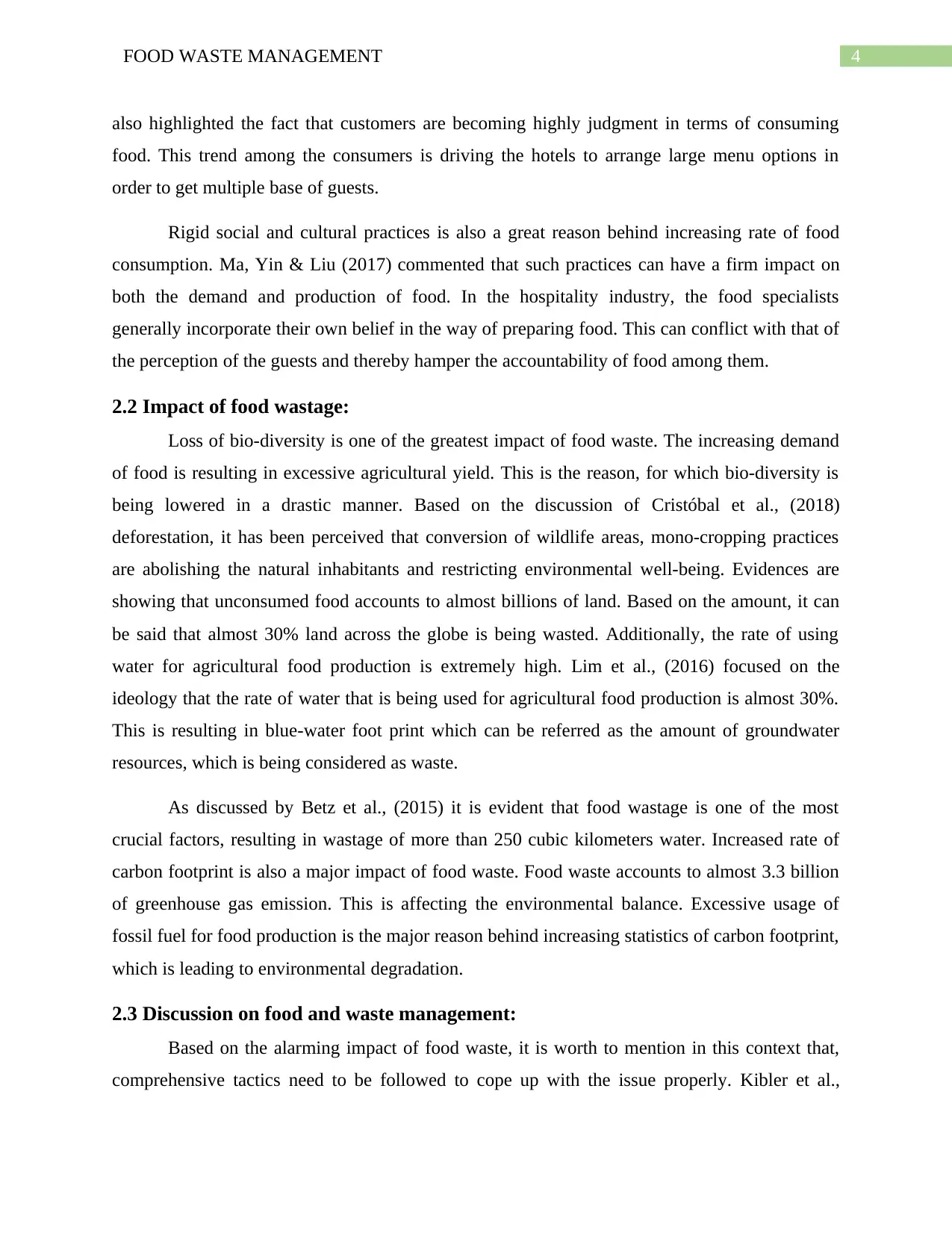
4FOOD WASTE MANAGEMENT
also highlighted the fact that customers are becoming highly judgment in terms of consuming
food. This trend among the consumers is driving the hotels to arrange large menu options in
order to get multiple base of guests.
Rigid social and cultural practices is also a great reason behind increasing rate of food
consumption. Ma, Yin & Liu (2017) commented that such practices can have a firm impact on
both the demand and production of food. In the hospitality industry, the food specialists
generally incorporate their own belief in the way of preparing food. This can conflict with that of
the perception of the guests and thereby hamper the accountability of food among them.
2.2 Impact of food wastage:
Loss of bio-diversity is one of the greatest impact of food waste. The increasing demand
of food is resulting in excessive agricultural yield. This is the reason, for which bio-diversity is
being lowered in a drastic manner. Based on the discussion of Cristóbal et al., (2018)
deforestation, it has been perceived that conversion of wildlife areas, mono-cropping practices
are abolishing the natural inhabitants and restricting environmental well-being. Evidences are
showing that unconsumed food accounts to almost billions of land. Based on the amount, it can
be said that almost 30% land across the globe is being wasted. Additionally, the rate of using
water for agricultural food production is extremely high. Lim et al., (2016) focused on the
ideology that the rate of water that is being used for agricultural food production is almost 30%.
This is resulting in blue-water foot print which can be referred as the amount of groundwater
resources, which is being considered as waste.
As discussed by Betz et al., (2015) it is evident that food wastage is one of the most
crucial factors, resulting in wastage of more than 250 cubic kilometers water. Increased rate of
carbon footprint is also a major impact of food waste. Food waste accounts to almost 3.3 billion
of greenhouse gas emission. This is affecting the environmental balance. Excessive usage of
fossil fuel for food production is the major reason behind increasing statistics of carbon footprint,
which is leading to environmental degradation.
2.3 Discussion on food and waste management:
Based on the alarming impact of food waste, it is worth to mention in this context that,
comprehensive tactics need to be followed to cope up with the issue properly. Kibler et al.,
also highlighted the fact that customers are becoming highly judgment in terms of consuming
food. This trend among the consumers is driving the hotels to arrange large menu options in
order to get multiple base of guests.
Rigid social and cultural practices is also a great reason behind increasing rate of food
consumption. Ma, Yin & Liu (2017) commented that such practices can have a firm impact on
both the demand and production of food. In the hospitality industry, the food specialists
generally incorporate their own belief in the way of preparing food. This can conflict with that of
the perception of the guests and thereby hamper the accountability of food among them.
2.2 Impact of food wastage:
Loss of bio-diversity is one of the greatest impact of food waste. The increasing demand
of food is resulting in excessive agricultural yield. This is the reason, for which bio-diversity is
being lowered in a drastic manner. Based on the discussion of Cristóbal et al., (2018)
deforestation, it has been perceived that conversion of wildlife areas, mono-cropping practices
are abolishing the natural inhabitants and restricting environmental well-being. Evidences are
showing that unconsumed food accounts to almost billions of land. Based on the amount, it can
be said that almost 30% land across the globe is being wasted. Additionally, the rate of using
water for agricultural food production is extremely high. Lim et al., (2016) focused on the
ideology that the rate of water that is being used for agricultural food production is almost 30%.
This is resulting in blue-water foot print which can be referred as the amount of groundwater
resources, which is being considered as waste.
As discussed by Betz et al., (2015) it is evident that food wastage is one of the most
crucial factors, resulting in wastage of more than 250 cubic kilometers water. Increased rate of
carbon footprint is also a major impact of food waste. Food waste accounts to almost 3.3 billion
of greenhouse gas emission. This is affecting the environmental balance. Excessive usage of
fossil fuel for food production is the major reason behind increasing statistics of carbon footprint,
which is leading to environmental degradation.
2.3 Discussion on food and waste management:
Based on the alarming impact of food waste, it is worth to mention in this context that,
comprehensive tactics need to be followed to cope up with the issue properly. Kibler et al.,
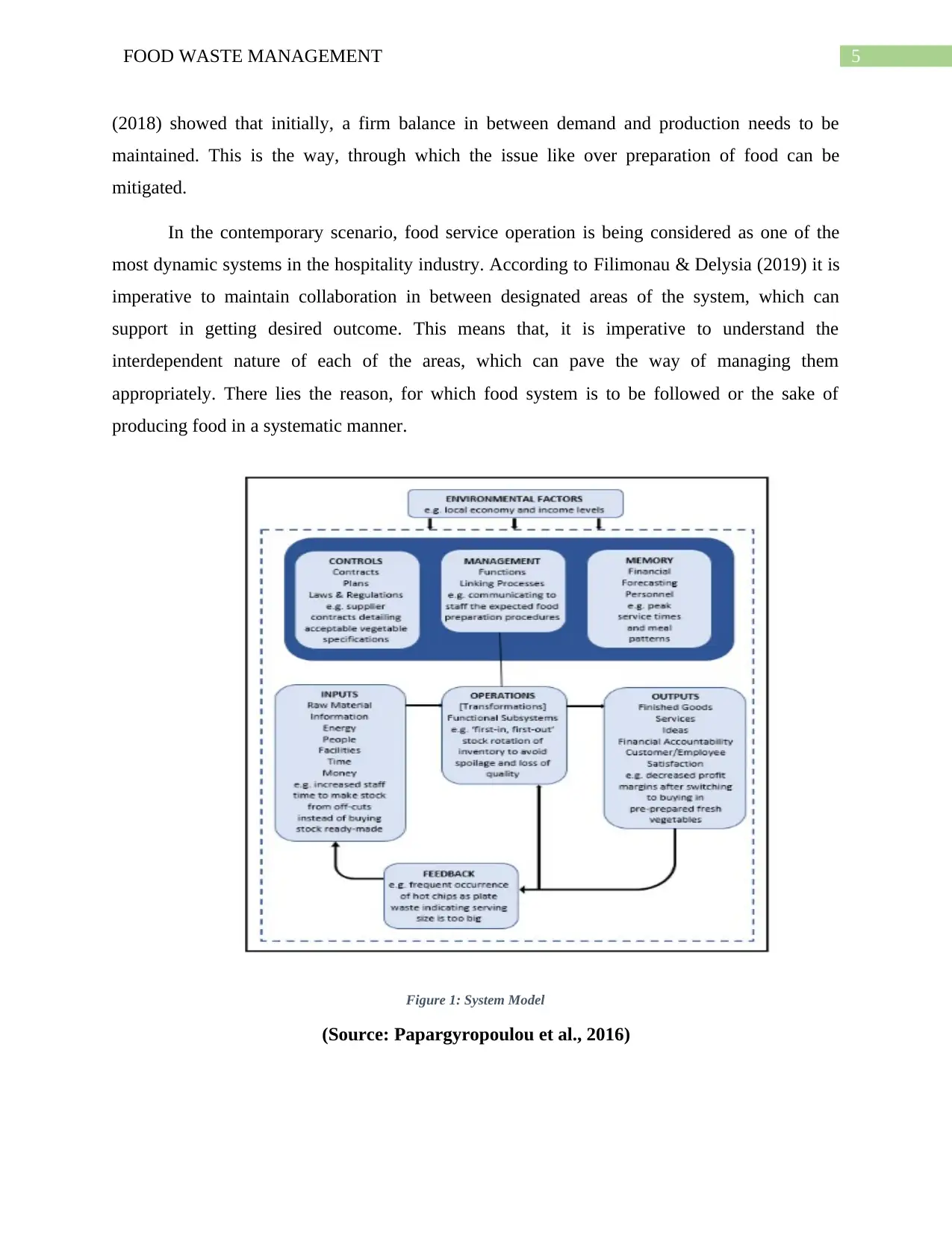
5FOOD WASTE MANAGEMENT
(2018) showed that initially, a firm balance in between demand and production needs to be
maintained. This is the way, through which the issue like over preparation of food can be
mitigated.
In the contemporary scenario, food service operation is being considered as one of the
most dynamic systems in the hospitality industry. According to Filimonau & Delysia (2019) it is
imperative to maintain collaboration in between designated areas of the system, which can
support in getting desired outcome. This means that, it is imperative to understand the
interdependent nature of each of the areas, which can pave the way of managing them
appropriately. There lies the reason, for which food system is to be followed or the sake of
producing food in a systematic manner.
Figure 1: System Model
(Source: Papargyropoulou et al., 2016)
(2018) showed that initially, a firm balance in between demand and production needs to be
maintained. This is the way, through which the issue like over preparation of food can be
mitigated.
In the contemporary scenario, food service operation is being considered as one of the
most dynamic systems in the hospitality industry. According to Filimonau & Delysia (2019) it is
imperative to maintain collaboration in between designated areas of the system, which can
support in getting desired outcome. This means that, it is imperative to understand the
interdependent nature of each of the areas, which can pave the way of managing them
appropriately. There lies the reason, for which food system is to be followed or the sake of
producing food in a systematic manner.
Figure 1: System Model
(Source: Papargyropoulou et al., 2016)
⊘ This is a preview!⊘
Do you want full access?
Subscribe today to unlock all pages.

Trusted by 1+ million students worldwide
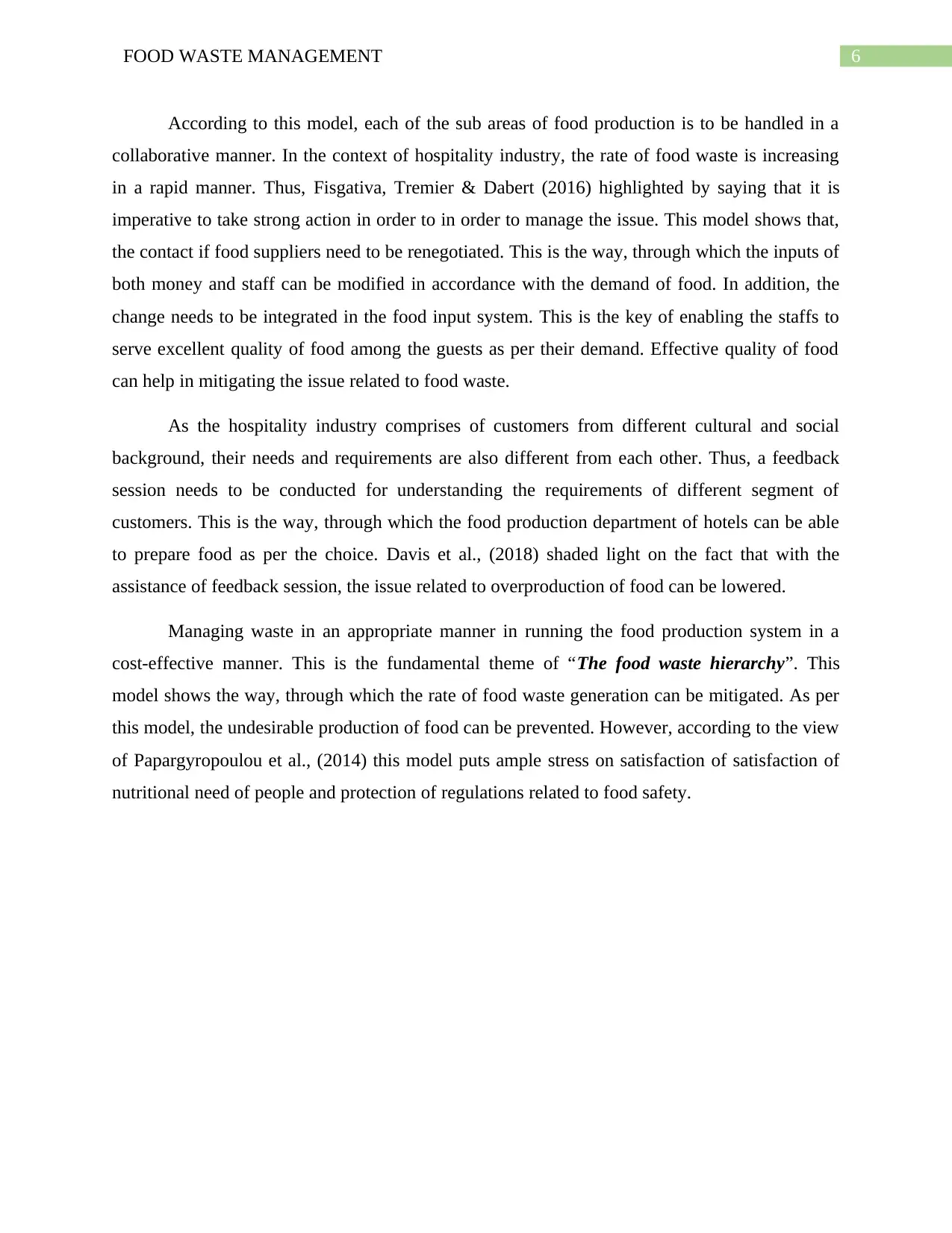
6FOOD WASTE MANAGEMENT
According to this model, each of the sub areas of food production is to be handled in a
collaborative manner. In the context of hospitality industry, the rate of food waste is increasing
in a rapid manner. Thus, Fisgativa, Tremier & Dabert (2016) highlighted by saying that it is
imperative to take strong action in order to in order to manage the issue. This model shows that,
the contact if food suppliers need to be renegotiated. This is the way, through which the inputs of
both money and staff can be modified in accordance with the demand of food. In addition, the
change needs to be integrated in the food input system. This is the key of enabling the staffs to
serve excellent quality of food among the guests as per their demand. Effective quality of food
can help in mitigating the issue related to food waste.
As the hospitality industry comprises of customers from different cultural and social
background, their needs and requirements are also different from each other. Thus, a feedback
session needs to be conducted for understanding the requirements of different segment of
customers. This is the way, through which the food production department of hotels can be able
to prepare food as per the choice. Davis et al., (2018) shaded light on the fact that with the
assistance of feedback session, the issue related to overproduction of food can be lowered.
Managing waste in an appropriate manner in running the food production system in a
cost-effective manner. This is the fundamental theme of “The food waste hierarchy”. This
model shows the way, through which the rate of food waste generation can be mitigated. As per
this model, the undesirable production of food can be prevented. However, according to the view
of Papargyropoulou et al., (2014) this model puts ample stress on satisfaction of satisfaction of
nutritional need of people and protection of regulations related to food safety.
According to this model, each of the sub areas of food production is to be handled in a
collaborative manner. In the context of hospitality industry, the rate of food waste is increasing
in a rapid manner. Thus, Fisgativa, Tremier & Dabert (2016) highlighted by saying that it is
imperative to take strong action in order to in order to manage the issue. This model shows that,
the contact if food suppliers need to be renegotiated. This is the way, through which the inputs of
both money and staff can be modified in accordance with the demand of food. In addition, the
change needs to be integrated in the food input system. This is the key of enabling the staffs to
serve excellent quality of food among the guests as per their demand. Effective quality of food
can help in mitigating the issue related to food waste.
As the hospitality industry comprises of customers from different cultural and social
background, their needs and requirements are also different from each other. Thus, a feedback
session needs to be conducted for understanding the requirements of different segment of
customers. This is the way, through which the food production department of hotels can be able
to prepare food as per the choice. Davis et al., (2018) shaded light on the fact that with the
assistance of feedback session, the issue related to overproduction of food can be lowered.
Managing waste in an appropriate manner in running the food production system in a
cost-effective manner. This is the fundamental theme of “The food waste hierarchy”. This
model shows the way, through which the rate of food waste generation can be mitigated. As per
this model, the undesirable production of food can be prevented. However, according to the view
of Papargyropoulou et al., (2014) this model puts ample stress on satisfaction of satisfaction of
nutritional need of people and protection of regulations related to food safety.
Paraphrase This Document
Need a fresh take? Get an instant paraphrase of this document with our AI Paraphraser
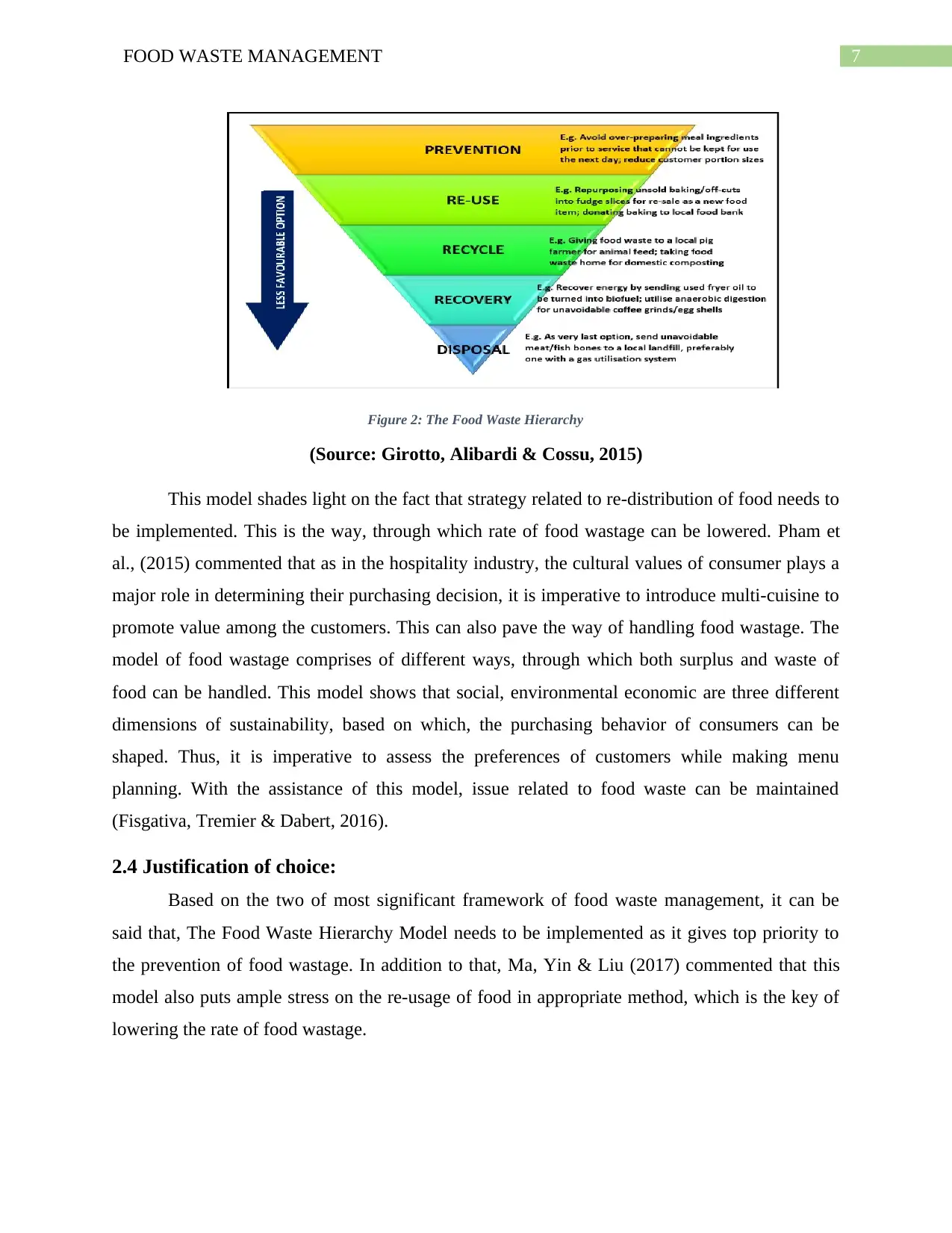
7FOOD WASTE MANAGEMENT
Figure 2: The Food Waste Hierarchy
(Source: Girotto, Alibardi & Cossu, 2015)
This model shades light on the fact that strategy related to re-distribution of food needs to
be implemented. This is the way, through which rate of food wastage can be lowered. Pham et
al., (2015) commented that as in the hospitality industry, the cultural values of consumer plays a
major role in determining their purchasing decision, it is imperative to introduce multi-cuisine to
promote value among the customers. This can also pave the way of handling food wastage. The
model of food wastage comprises of different ways, through which both surplus and waste of
food can be handled. This model shows that social, environmental economic are three different
dimensions of sustainability, based on which, the purchasing behavior of consumers can be
shaped. Thus, it is imperative to assess the preferences of customers while making menu
planning. With the assistance of this model, issue related to food waste can be maintained
(Fisgativa, Tremier & Dabert, 2016).
2.4 Justification of choice:
Based on the two of most significant framework of food waste management, it can be
said that, The Food Waste Hierarchy Model needs to be implemented as it gives top priority to
the prevention of food wastage. In addition to that, Ma, Yin & Liu (2017) commented that this
model also puts ample stress on the re-usage of food in appropriate method, which is the key of
lowering the rate of food wastage.
Figure 2: The Food Waste Hierarchy
(Source: Girotto, Alibardi & Cossu, 2015)
This model shades light on the fact that strategy related to re-distribution of food needs to
be implemented. This is the way, through which rate of food wastage can be lowered. Pham et
al., (2015) commented that as in the hospitality industry, the cultural values of consumer plays a
major role in determining their purchasing decision, it is imperative to introduce multi-cuisine to
promote value among the customers. This can also pave the way of handling food wastage. The
model of food wastage comprises of different ways, through which both surplus and waste of
food can be handled. This model shows that social, environmental economic are three different
dimensions of sustainability, based on which, the purchasing behavior of consumers can be
shaped. Thus, it is imperative to assess the preferences of customers while making menu
planning. With the assistance of this model, issue related to food waste can be maintained
(Fisgativa, Tremier & Dabert, 2016).
2.4 Justification of choice:
Based on the two of most significant framework of food waste management, it can be
said that, The Food Waste Hierarchy Model needs to be implemented as it gives top priority to
the prevention of food wastage. In addition to that, Ma, Yin & Liu (2017) commented that this
model also puts ample stress on the re-usage of food in appropriate method, which is the key of
lowering the rate of food wastage.
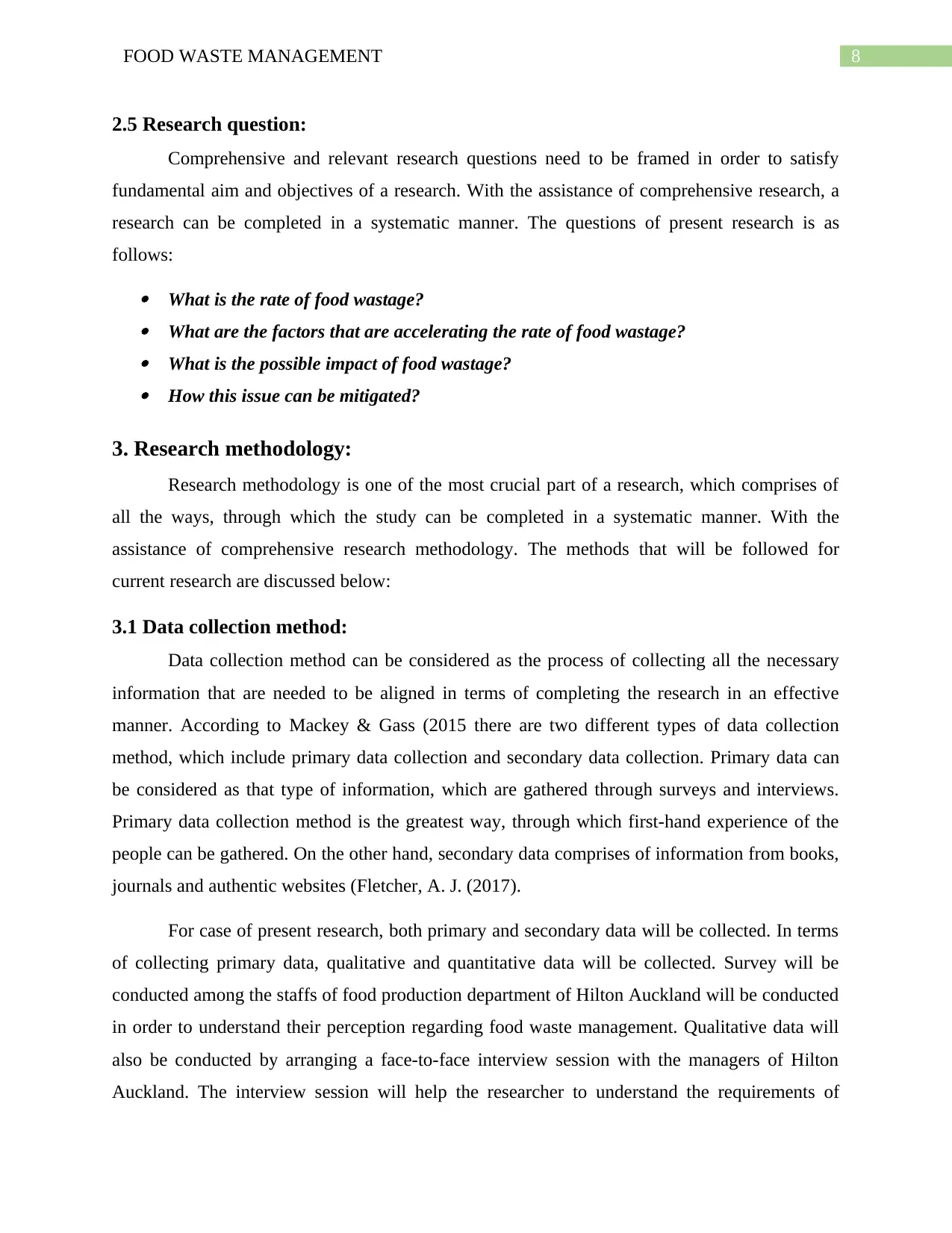
8FOOD WASTE MANAGEMENT
2.5 Research question:
Comprehensive and relevant research questions need to be framed in order to satisfy
fundamental aim and objectives of a research. With the assistance of comprehensive research, a
research can be completed in a systematic manner. The questions of present research is as
follows: What is the rate of food wastage? What are the factors that are accelerating the rate of food wastage? What is the possible impact of food wastage? How this issue can be mitigated?
3. Research methodology:
Research methodology is one of the most crucial part of a research, which comprises of
all the ways, through which the study can be completed in a systematic manner. With the
assistance of comprehensive research methodology. The methods that will be followed for
current research are discussed below:
3.1 Data collection method:
Data collection method can be considered as the process of collecting all the necessary
information that are needed to be aligned in terms of completing the research in an effective
manner. According to Mackey & Gass (2015 there are two different types of data collection
method, which include primary data collection and secondary data collection. Primary data can
be considered as that type of information, which are gathered through surveys and interviews.
Primary data collection method is the greatest way, through which first-hand experience of the
people can be gathered. On the other hand, secondary data comprises of information from books,
journals and authentic websites (Fletcher, A. J. (2017).
For case of present research, both primary and secondary data will be collected. In terms
of collecting primary data, qualitative and quantitative data will be collected. Survey will be
conducted among the staffs of food production department of Hilton Auckland will be conducted
in order to understand their perception regarding food waste management. Qualitative data will
also be conducted by arranging a face-to-face interview session with the managers of Hilton
Auckland. The interview session will help the researcher to understand the requirements of
2.5 Research question:
Comprehensive and relevant research questions need to be framed in order to satisfy
fundamental aim and objectives of a research. With the assistance of comprehensive research, a
research can be completed in a systematic manner. The questions of present research is as
follows: What is the rate of food wastage? What are the factors that are accelerating the rate of food wastage? What is the possible impact of food wastage? How this issue can be mitigated?
3. Research methodology:
Research methodology is one of the most crucial part of a research, which comprises of
all the ways, through which the study can be completed in a systematic manner. With the
assistance of comprehensive research methodology. The methods that will be followed for
current research are discussed below:
3.1 Data collection method:
Data collection method can be considered as the process of collecting all the necessary
information that are needed to be aligned in terms of completing the research in an effective
manner. According to Mackey & Gass (2015 there are two different types of data collection
method, which include primary data collection and secondary data collection. Primary data can
be considered as that type of information, which are gathered through surveys and interviews.
Primary data collection method is the greatest way, through which first-hand experience of the
people can be gathered. On the other hand, secondary data comprises of information from books,
journals and authentic websites (Fletcher, A. J. (2017).
For case of present research, both primary and secondary data will be collected. In terms
of collecting primary data, qualitative and quantitative data will be collected. Survey will be
conducted among the staffs of food production department of Hilton Auckland will be conducted
in order to understand their perception regarding food waste management. Qualitative data will
also be conducted by arranging a face-to-face interview session with the managers of Hilton
Auckland. The interview session will help the researcher to understand the requirements of
⊘ This is a preview!⊘
Do you want full access?
Subscribe today to unlock all pages.

Trusted by 1+ million students worldwide

9FOOD WASTE MANAGEMENT
guests from different cultural background. In the context of secondary research, in-depth
literature review will be conducted to explore different terminologies of food waste management.
Academic journal and authentic websites will only be reviewed to gather relevant result.
3.2 Sampling technique:
There are two different types of sampling techniques- probability and non-probability
sampling technique that are generally being followed in completion of a research. Probability
sampling technique is the major way, through which respondents can be chosen in a simple way
(Taylor, Bogdan & DeVault, 2015). On the other hand, non-probability sampling restricts the
way of choosing sample in a random way. In order to conduct the present research, non-
probability sampling method will be followed.
3.3 Participants:
In a research, the participants play a major role by expressing their belief and perception
regarding an issue. This is the way, through which the researcher becomes able to strengthen the
value of research. For the present research, the working professionals from Hilton Auckland will
be surveyed and interviews. This is will help the researcher to gather their perception regarding
food waste management.
3.4 Data analysis methods:
Flick (2015) said that data analysis method can be considered as the way of analyzing
and framing the data in an appropriate manner, which is the key of getting helpful details and
thus making a comprehensive conclusion. Qualitative and quantitative are also being considered
as two of the major data collection methods. Qualitative Data Analysis technique can be
considered as the process, through which the researcher transforms the data into explanation.
This is the way, through which comprehensive theme of a research can be developed. Contrarily,
qualitative data collection method is the way of analyzing data through statistical representation
(Ledford & Gast, 2018). For the case of this research, quantitative data collection method will be
followed. 40 staffs from the food production department of Hilton Auckland will be selected and
their responses will be presented in MS Excel.
3.5 Time frame:
Activities Time frame
guests from different cultural background. In the context of secondary research, in-depth
literature review will be conducted to explore different terminologies of food waste management.
Academic journal and authentic websites will only be reviewed to gather relevant result.
3.2 Sampling technique:
There are two different types of sampling techniques- probability and non-probability
sampling technique that are generally being followed in completion of a research. Probability
sampling technique is the major way, through which respondents can be chosen in a simple way
(Taylor, Bogdan & DeVault, 2015). On the other hand, non-probability sampling restricts the
way of choosing sample in a random way. In order to conduct the present research, non-
probability sampling method will be followed.
3.3 Participants:
In a research, the participants play a major role by expressing their belief and perception
regarding an issue. This is the way, through which the researcher becomes able to strengthen the
value of research. For the present research, the working professionals from Hilton Auckland will
be surveyed and interviews. This is will help the researcher to gather their perception regarding
food waste management.
3.4 Data analysis methods:
Flick (2015) said that data analysis method can be considered as the way of analyzing
and framing the data in an appropriate manner, which is the key of getting helpful details and
thus making a comprehensive conclusion. Qualitative and quantitative are also being considered
as two of the major data collection methods. Qualitative Data Analysis technique can be
considered as the process, through which the researcher transforms the data into explanation.
This is the way, through which comprehensive theme of a research can be developed. Contrarily,
qualitative data collection method is the way of analyzing data through statistical representation
(Ledford & Gast, 2018). For the case of this research, quantitative data collection method will be
followed. 40 staffs from the food production department of Hilton Auckland will be selected and
their responses will be presented in MS Excel.
3.5 Time frame:
Activities Time frame
Paraphrase This Document
Need a fresh take? Get an instant paraphrase of this document with our AI Paraphraser
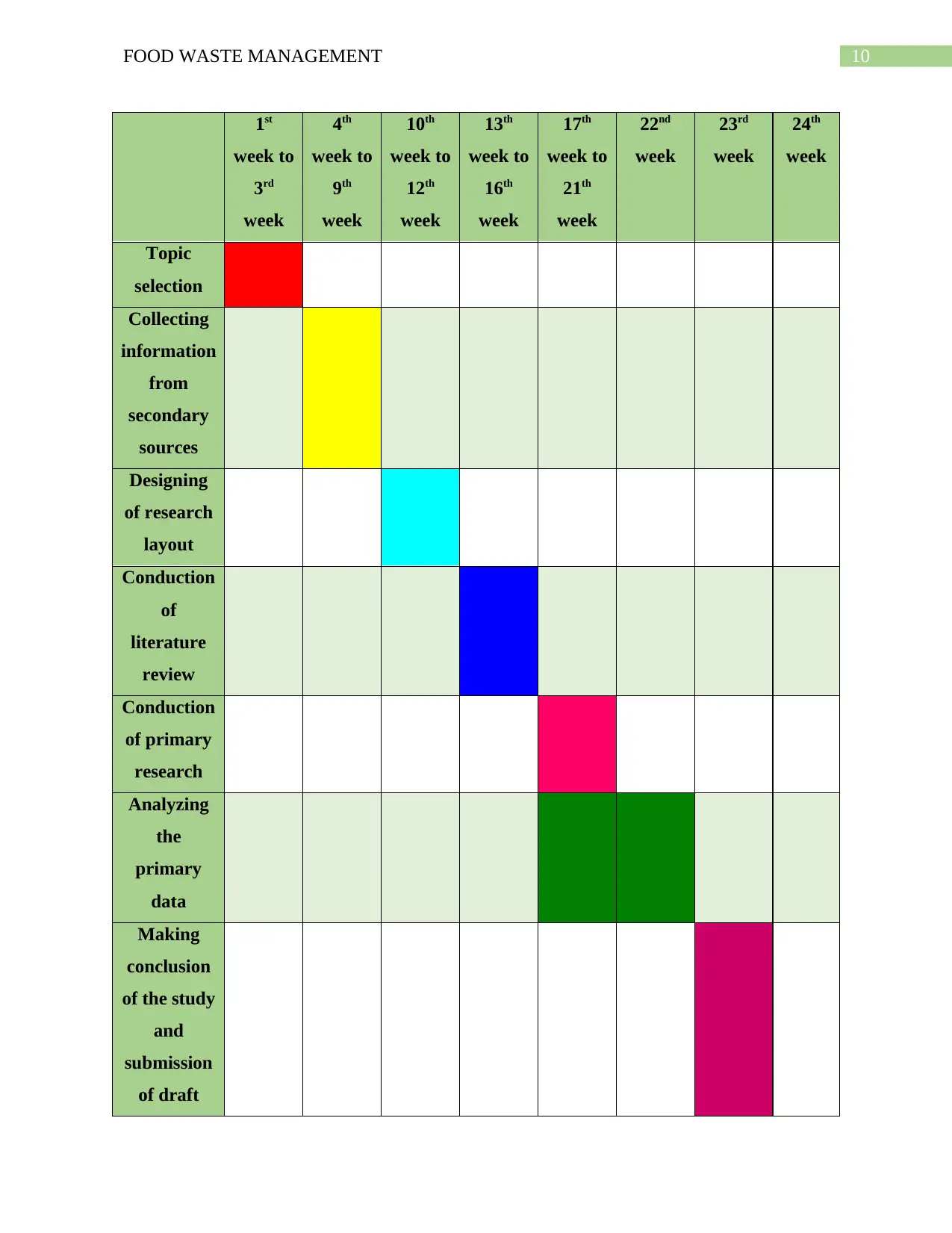
10FOOD WASTE MANAGEMENT
1st
week to
3rd
week
4th
week to
9th
week
10th
week to
12th
week
13th
week to
16th
week
17th
week to
21th
week
22nd
week
23rd
week
24th
week
Topic
selection
Collecting
information
from
secondary
sources
Designing
of research
layout
Conduction
of
literature
review
Conduction
of primary
research
Analyzing
the
primary
data
Making
conclusion
of the study
and
submission
of draft
1st
week to
3rd
week
4th
week to
9th
week
10th
week to
12th
week
13th
week to
16th
week
17th
week to
21th
week
22nd
week
23rd
week
24th
week
Topic
selection
Collecting
information
from
secondary
sources
Designing
of research
layout
Conduction
of
literature
review
Conduction
of primary
research
Analyzing
the
primary
data
Making
conclusion
of the study
and
submission
of draft
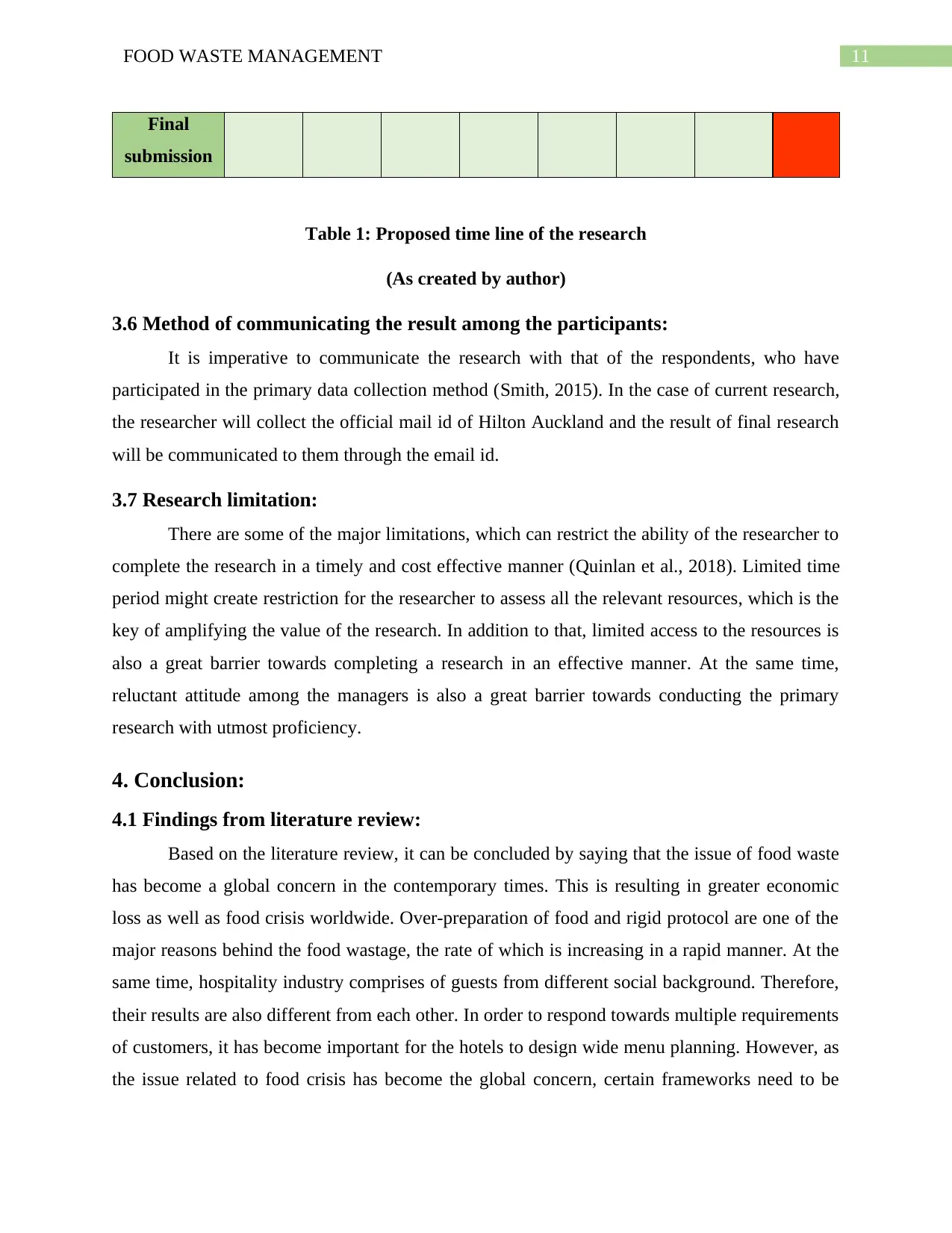
11FOOD WASTE MANAGEMENT
Final
submission
Table 1: Proposed time line of the research
(As created by author)
3.6 Method of communicating the result among the participants:
It is imperative to communicate the research with that of the respondents, who have
participated in the primary data collection method (Smith, 2015). In the case of current research,
the researcher will collect the official mail id of Hilton Auckland and the result of final research
will be communicated to them through the email id.
3.7 Research limitation:
There are some of the major limitations, which can restrict the ability of the researcher to
complete the research in a timely and cost effective manner (Quinlan et al., 2018). Limited time
period might create restriction for the researcher to assess all the relevant resources, which is the
key of amplifying the value of the research. In addition to that, limited access to the resources is
also a great barrier towards completing a research in an effective manner. At the same time,
reluctant attitude among the managers is also a great barrier towards conducting the primary
research with utmost proficiency.
4. Conclusion:
4.1 Findings from literature review:
Based on the literature review, it can be concluded by saying that the issue of food waste
has become a global concern in the contemporary times. This is resulting in greater economic
loss as well as food crisis worldwide. Over-preparation of food and rigid protocol are one of the
major reasons behind the food wastage, the rate of which is increasing in a rapid manner. At the
same time, hospitality industry comprises of guests from different social background. Therefore,
their results are also different from each other. In order to respond towards multiple requirements
of customers, it has become important for the hotels to design wide menu planning. However, as
the issue related to food crisis has become the global concern, certain frameworks need to be
Final
submission
Table 1: Proposed time line of the research
(As created by author)
3.6 Method of communicating the result among the participants:
It is imperative to communicate the research with that of the respondents, who have
participated in the primary data collection method (Smith, 2015). In the case of current research,
the researcher will collect the official mail id of Hilton Auckland and the result of final research
will be communicated to them through the email id.
3.7 Research limitation:
There are some of the major limitations, which can restrict the ability of the researcher to
complete the research in a timely and cost effective manner (Quinlan et al., 2018). Limited time
period might create restriction for the researcher to assess all the relevant resources, which is the
key of amplifying the value of the research. In addition to that, limited access to the resources is
also a great barrier towards completing a research in an effective manner. At the same time,
reluctant attitude among the managers is also a great barrier towards conducting the primary
research with utmost proficiency.
4. Conclusion:
4.1 Findings from literature review:
Based on the literature review, it can be concluded by saying that the issue of food waste
has become a global concern in the contemporary times. This is resulting in greater economic
loss as well as food crisis worldwide. Over-preparation of food and rigid protocol are one of the
major reasons behind the food wastage, the rate of which is increasing in a rapid manner. At the
same time, hospitality industry comprises of guests from different social background. Therefore,
their results are also different from each other. In order to respond towards multiple requirements
of customers, it has become important for the hotels to design wide menu planning. However, as
the issue related to food crisis has become the global concern, certain frameworks need to be
⊘ This is a preview!⊘
Do you want full access?
Subscribe today to unlock all pages.

Trusted by 1+ million students worldwide
1 out of 18
Related Documents
Your All-in-One AI-Powered Toolkit for Academic Success.
+13062052269
info@desklib.com
Available 24*7 on WhatsApp / Email
![[object Object]](/_next/static/media/star-bottom.7253800d.svg)
Unlock your academic potential
Copyright © 2020–2025 A2Z Services. All Rights Reserved. Developed and managed by ZUCOL.





